E' ormai noto che quando una persona, soprattutto di sesso femminile, vive una vita ricolma di delusioni fino all'infelicità,

sia indotta a rapportarsi in maniera conflittuale con il cibo quasi a volersi punire, castigare, sentendosi responsabile, ovviamente in modo inconscio, di un destino che avrebbe voluto, e fors'anche meritato, molto meno amaro.
Ebbene, tale era l'atteggiamento della nostra amata Imperatrice che spesso evitava cene ufficiali e di rappresentanza ed al fianco dell'Imperatore spesso presenziava in sua vece l'amata figlia Marie Valerie, che faceva il proprio ingresso nella sala dove si sarebbe dovuto tenere il banchetto tenendo il padre sotto braccio.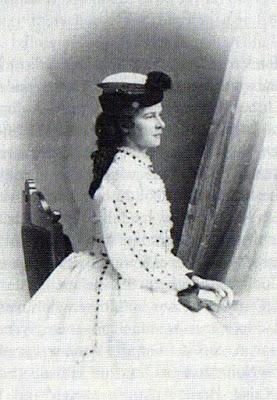
Sovente ella si sottoponeva a drastici digiuni o si concedeva un solo pasto al giorno secondo regole che si auto-imponeva seguendo diete diverse in base al suo umore, destando da una parte lo stupore dell'opinione pubblica che sempre più vedeva in lei una persona stravagante, dall'altra la preoccupazione dei suoi familiari che assistevano impotenti a questi 'rituali'.
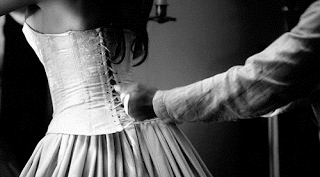
Si legge sulla biografia di Gabriele Praschl-Bichler, edita da Longanesi nel 1997, che ella
" Un'attenzione addirittura religiosa dedicò al corpo, che controllava in continuazione. Misure e peso erano annotati fino a tre volte al giorno, su un apposito quaderno [...] Si informava su ogni metodo di dimagramento e sperimentò centinaia di diete [...] beveva misture fatte da uova crude e succhi spremuti da carne cruda, oltre a litri di latte fresco ( allora era diffusa la convinzione che il latte conservasse il corpo snello e affusolato ). Sempre per amor della linea l'Imperatrice si dedicava a vari esercizi sportivi ( soprattutto equitazione e scherma), praticandoli, tuttavia, come quasi tutte le sue passioni, con un'intensità quasi ossessiva." 1 e da ciò si desume, come del resto accade per la maggior parte degli atleti, l'ovvietà del calo fisico che subì dopo i quarant'anni quando si dovette limitare a compiere lunghe passeggiate e ad abbandonare l'equitazione per il mal di schiena ed una forma di artrosi.
Se teniamo conto del fatto che l'Imperatrice era alta 1,72 cm. e pesava sempre intorno ai 46 kg., la sua era una silhouette che si faceva sicuramente notare.
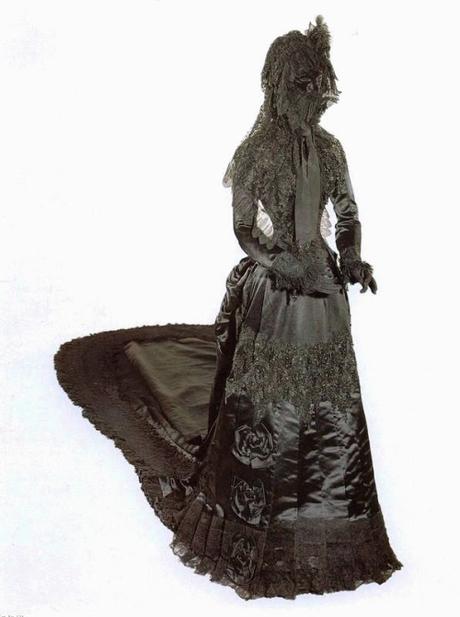
Abito appartenuto all'imperatrice da cui si evince chiaramente la sua marcata esilità.
Ma torniamo al latte, che per Elisabeth era davvero irrinunciabile e che non era facilmente reperibile ...
"Trovare del latte buono era difficile persino a Vienna. Per questo motivo l'imperatrice mandava spesso, quando era in viaggio, delle mucche per l'imperatore nella capitale. Così, per esempio, arrivarono nell'aprile del 1896 due mucche a Vienna, una dalla Bretagna e l'altra da Corfù e questa è anche una testimonianza dei viaggi dell'imperatrice. L'imperatrice possedeva una fattoria a Schönbrunn e un'altra nel Tiergarten di Leinz, entrambe popolate dalle sue mucche preferite, e di solito portava con sé in viaggio, perlomeno quando s'imbarcava su qualche nave, due mucche da latte ed una capra, per poter disporre sempre di latte fresco e sano. Prendersi cura di questi animali - certo non abituati a trascorrere la vita in navigazione - era un compito piuttosto faticoso per il seguito dell'imperatrice. Dalla salute di queste bestie, infatti, dipendeva anche quella dell'imperatrice, che ormai si nutriva quasi esclusivamente di latte e uova."2
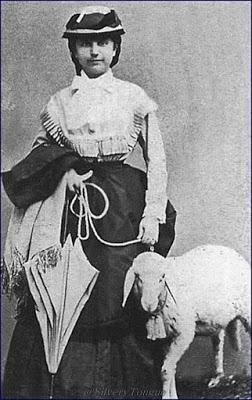
La fedelissima dama di compagnia Ida Ferenczy immortalata mentre l'Imperatrice si stava preparando per un viaggio.
Ebbene sì, per fare in modo che l'imperatrice disponesse di latte fresco ogni giorno, mucche speciali di varie razze, tutte da latte, erano allevate per le sue esigenze: Inntal, Pinzgau, capi italiani francesi e Montafon, così come pure bestiame proveniente dall'Ungheria e dalla Grecia, come abbiamo appena letto sopra; al fine di accogliere il crescente numero di ruminanti, nel 1895 il venne istituito il Kammermeierei
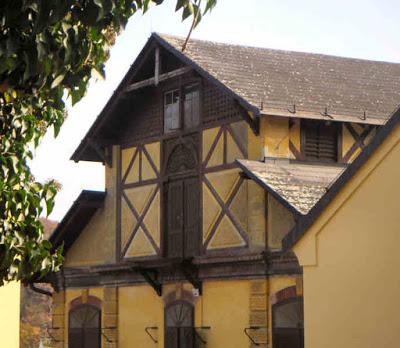
( in italiano potremmo dire latteria o caseificio ) presso l'ex Giardino Tirolese nel parco del Castello di Schönbrunn
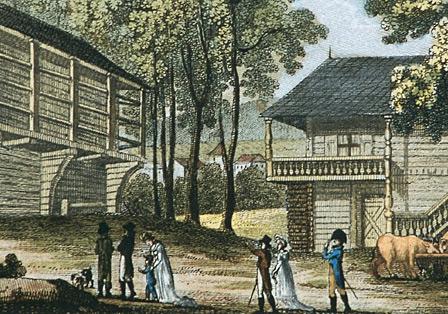
Der Tirolergarten in Schönbrunn
e la Casa del cacciatore fu ampliata per ospitare una stalla, sale di mungitura ed un magazzino di mangimi. Elisabeth possedeva un piccolo appartamento situato nel caseificio con ingresso, spogliatoio e sala da pranzo, che conteneva mobili rossi verniciati e decorati con motivi floreali nello stile proprio di una casa colonica ungherese
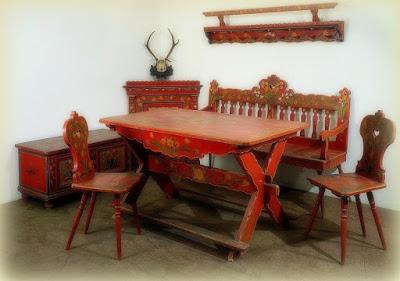
ed utilizzava un servizio di piatti in tono con tali decorazioni.
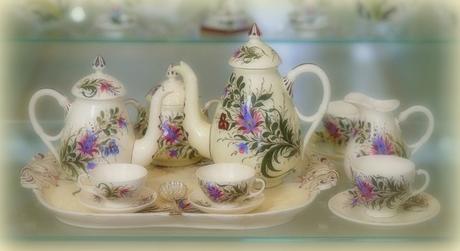
) Il complesso, che includeva anche un alloggio per un custode, doveva contenere circa 10 - 12 mucche più un torello, ma con il giugno dell'anno 1896, la stalla di Schönbrunn giunse ad ospitare persino 26 capi di bestiame, di cui tre erano buoi, oltre a numerosi polli. Prodotti freschi come latte, burro, panna e uova venivano fatti giungere da qui alla corte di modo che tutti i membri della famiglia imperiale potessero cibarsene.
Di conseguenza, l'operazione di prodotti lattiero-caseari proseguì anche dopo la morte dell'imperatrice nel 1898. Al Kammermeierei attingevano anche l'Imperiale e la Reale Pasticceria ( Zuckerbäckerei ed al fine di fornire dolciumi di qualità particolarmente buona, quando annotava i propri ordini, il pasticcere specificava quale doveva essere la mucca da cui desiderava avere latte o panna, dal momento che la qualità ed il tenore di materia grassa del latte varia considerevolmente da razza a razza.
E chissà che non sia stata proprio la genuinità dei pochi alimenti da cui l'imperatrice traeva sostentamento a garantirle quel po' di salute che difficilmente le persone con atteggiamenti che palesano disturbi di natura anoressica possono vantare.
Ebbene, è giunto ormai tempo che l'Eterea Imperatrice ci saluti
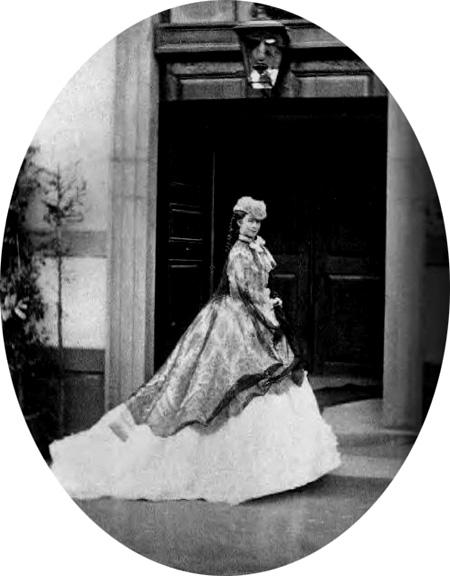
e rientri tra le mura dei suoi palazzi,
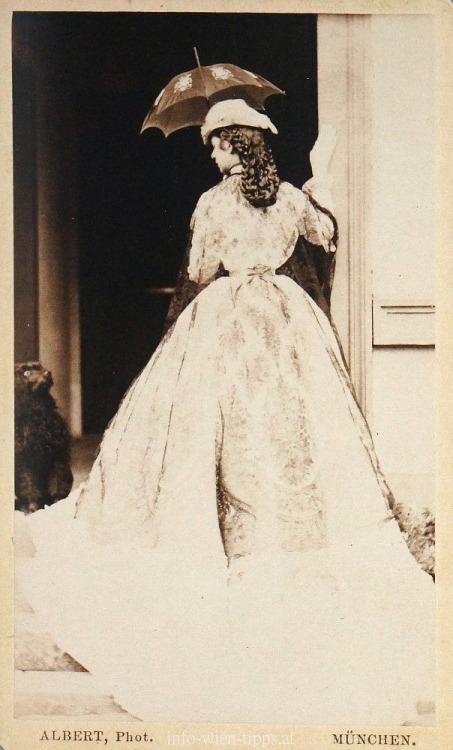
per tornare a svelarci altri aneddoti o curiosità sulla sua vita ogni qualvolta lo desidereremmo, e noi umilmente chiniamo il capo innanzi a Cotanta Maestà e speriamo presto di poter ancora parlare di Lei.
Un affettuoso saluto ... a voi tutti, ed un arrivederci ...
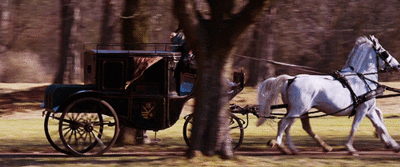

Hellmut Andics, Die Frauen der Habsburger, WILHELM HEYNE VERLAG, München , 1995
Elisabetta d'Austria, Diario poetico, MGS PRESS SAS, 1998
ELISABETTA D'AUSTRIA NEI FOGLI DI DIARIO DI COSTANTIN CHRISTOMANOS, Adelphi edizioni S.p.A., Milano, 1989
Maria Valeria d'Asburgo, La prediletta - Il diario della figlia di Sissi, a cura di Martha e Horst Schad, traduzione di Flavia Floradini, MGS PRESS, 2001
Conte Egon Cesar Corti, L'imperatrice Elisabetta, Mondadori, Milano, 1937
Brigitte Hamann, Elisabeth. Kaiserin wieder Willen, Amalthea Verlag, Wien, München , 1982
Brigitte Hamann, (a cura di), ELISABETH Bilder einer Kaiserin, Amalthea Verlag, 1998
Gabriele Praschl - Bichler, L'Imperatrice Elisabetta, Longanesi & C., Milano, 1997
1 - Gabriele Praschl - Bichler, L'Imperatrice Elisabetta, Longanesi & C., Milano, 1997, pag. 225
2 - Brigitte Hamann, Elisabeth. Kaiserin wieder Willen, Amalthea Verlag, Wien, München , 1982, pag.397

It's well known, nowadays, that when a person, especially women, living a life full of disappointments until unhappiness,
begins to relate in a conflictual way with the food almost as if to punish herself, for feeling responsible, of course unconsciously, of a destiny that she wanted, and perhaps deserved, much less bitter.
Well, that was the attitude of our beloved Empress who often avoided official and representation dinners and at the Emperor's side often was attending in her place her beloved daughter Marie Valerie, who entered the room where it would have to keep the banquet taking his father's arm.
Often she underwent a drastic fasting or she allowed only one meal per day according to rules that were self-imposed following different diets according to her mood, raising, on one hand, the amazement of the public opinion who increasingly saw in her an oddball lady and on the other the concern of her family who saw, powerless, these 'rituals'.
We may readin the biography of Gabriele Praschl-Bichler, published by Longanesi in 1997, that she
"An attention even religious payd to her body, which she controlled again and again during the day. Measurements and weight were recorded up to three times a day, on a special notebook [...] She is informed on every method of slimming and has experienced hundreds of diets [. ..] she drank mixtures made from raw eggs and squeezed juices from raw meat, over a liter of fresh milk (then it was widely believed that milk preserves the body slender and tapered). Also for the love of her figure she the Empress devoted herself to various sport activities (especially riding and fencing), practicing them, however, as almost every passion of hers, with an almost obsessive way. " and from that we desume, as it is the case for most of the athletes, the obviousness of her physical decline that she suffered after the forty years when she had to satisfy her wish with having long walks and had to give up riding for back pain and a for a form of arthritis. .
If we take into account the fact that the Empress was 1.72 cm. tall and always weighed around 46 kg., hers was a silhouette that was definitely impossible not to notice.
Dress owned by the Empress, which shows clearly her marked thinness.
But let's come back to the milk, that foe Elisabeth was really essential and that it wasn't so easy to find ...
"Finding good milk was difficult even in Vienna. For this reason, the Empress often sent, when she was abtroad, some cows for the emperor in the capital. So, for example, they arrived in April 1896 in Vienna two cows, one from Britain and one from Corfu, and this is also a testimony of empress' travels. The Empress had a farm in Schönbrunn and another in the Tiergarten of Leinz, both populated by her favorite cows, and usually took with her on travel, at least when she embarked on a ship, two cows and a goat, to have always fresh and healthy milk. Taking care of these animals - certainly not accustomed to spend their lives on the sea - it was a pretty hard task for the follow of the Empress. From the health of these animals, in fact, depended also the Empress' one, who now fed almost exclusively of milk and eggs." 2
The faithful lady-in-waiting Ida Ferenczy immortalized when the Empress was preparing for a trip.
Yes, to ensure that the Empress possessed fresh milk every day, special cows of various breeds, all for milk, were bred for her needs: Inntal, Pinzgau, French and Italian and Montafon, as well as cattle coming from Hungary and Greece, as we just read above; in order to accommodate the growing number of ruminants, in 1895, it was established the
Kammermeierei
- picture 7 - (In English we may say dairy) in the former Tyrolean Garden in the Schönbrunn Palace Park Der Tirolergarten in Schönbrunn
and the was enlarged to accommodate a barn, a milking parlor and a stock of feed. Elisabeth owned a small apartment located in the dairy entrance, a dressing room and a dining room, which contained red furniture painted and decorated with floral motifs in the style typical of a Hungarian farmhouse
- picture 8
'House of the Hunter'
and used a set of dishes which harmonized with those decorations.
The complex, which included accommodation for a caretaker, was able to contain about 10 to 12 cows and a bull, but since June 1896, the stable of Schönbrunn came to accommodate even 26 head of cattle, three of which were oxen , in addition to numerous chickens. Fresh products such as milk, butter, cream and eggs, were made to reach from here to the Court so that all the members of the Imperial Family could eat them. As a result, the operation of dairy products continued even after the death of the Empress in 1898. At the Kammermeierei also drew the Imperial and Royal Pastry (Zuckerbäckerei) and to provide sweets of especially good quality, when he noted his orders, the pastry chef had to specify which one was the cow from which wanted to have the milk or cream, as the quality and content of fat of the milk range considerably from breed to breed. And I wonder if it was just the genuineness of the few foods from which the Empress drew her sustenance to assure her that little health that hardly people with attitudes that reveal disturbances of anorexic nature cannot boast.
Well, it has arrived the time that the ethereal Empress greets us
to come back within the walls of her buildings,
- picture 11
to reveal again other anecdotes or curiosities about her life whenever we would wish, and we humbly bow our heads in fron of such Great Majesty and hope we can still talk about her very soon.
An affectionate greeting ... to you all, and see you soon ...
very soon
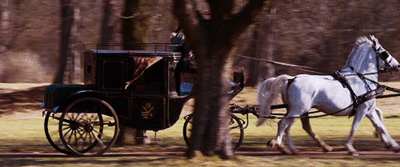

Hellmut Andics, Die Frauen der Habsburger, WILHELM HEYNE VERLAG, München , 1995
Elisabetta d'Austria, Diario poetico, MGS PRESS SAS, 1998
ELISABETTA D'AUSTRIA NEI FOGLI DI DIARIO DI COSTANTIN CHRISTOMANOS, Adelphi edizioni S.p.A., Milano, 1989
Maria Valeria d'Asburgo, La prediletta - Il diario della figlia di Sissi, a cura di Martha e Horst Schad, traduzione di Flavia Floradini, MGS PRESS, 2001
Conte Egon Cesar Corti, L'imperatrice Elisabetta, Mondadori, Milano, 1937
Brigitte Hamann, Elisabeth. Kaiserin wieder Willen, Amalthea Verlag, Wien, München , 1982
Brigitte Hamann, (a cura di), ELISABETH Bilder einer Kaiserin, Amalthea Verlag, 1998
Gabriele Praschl - Bichler, L'Imperatrice Elisabetta, Longanesi & C., Milano, 1997
1 - Gabriele Praschl - Bichler, L'Imperatrice Elisabetta, Longanesi & C., Milano, 1997, page 225
2 - Brigitte Hamann, Elisabeth. Kaiserin wieder Willen, Amalthea Verlag, Wien, München , 1982, page 397.
This post is linked up to this lovely blog


